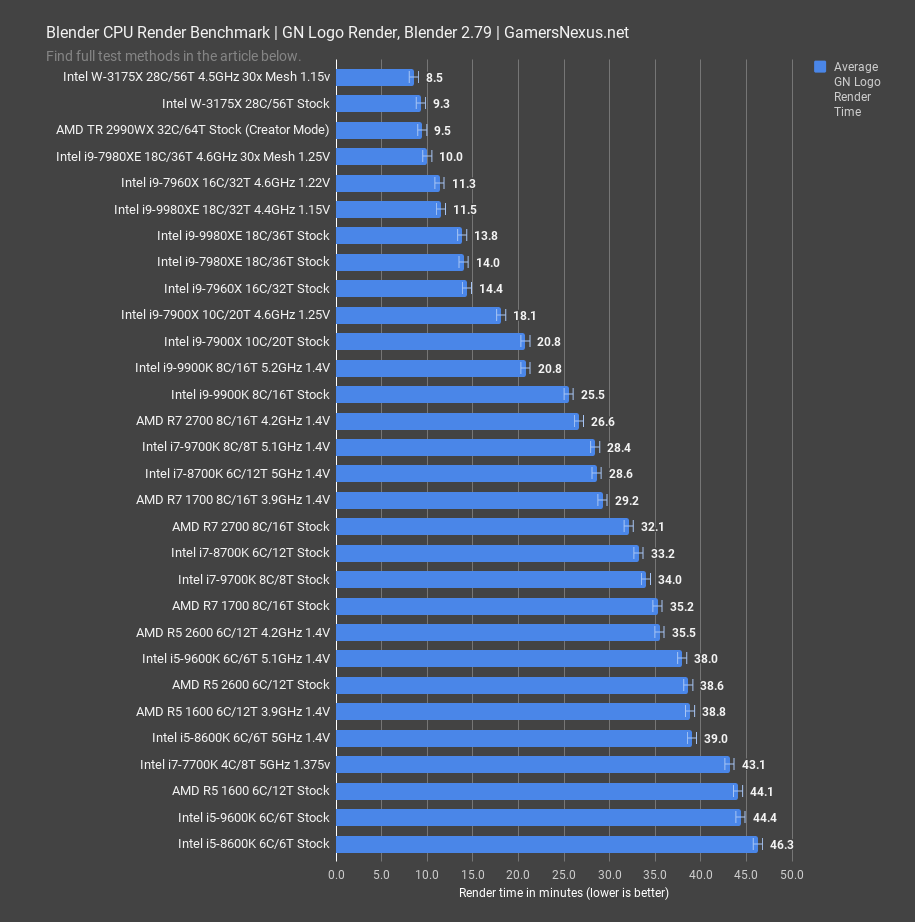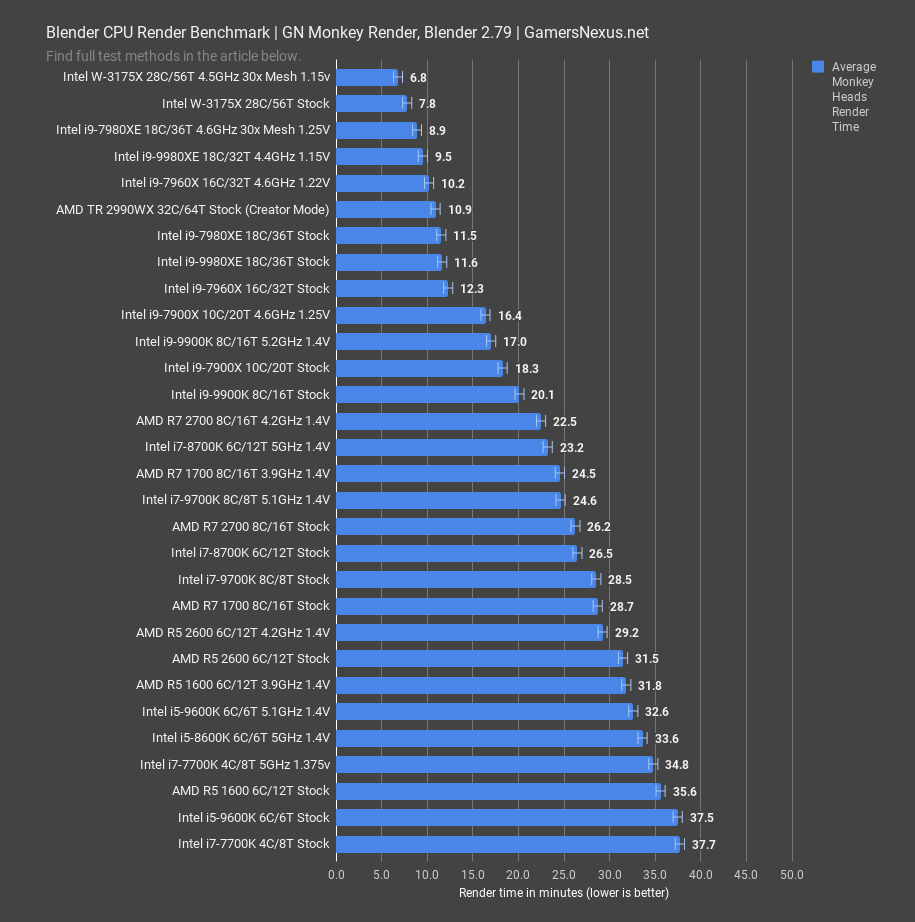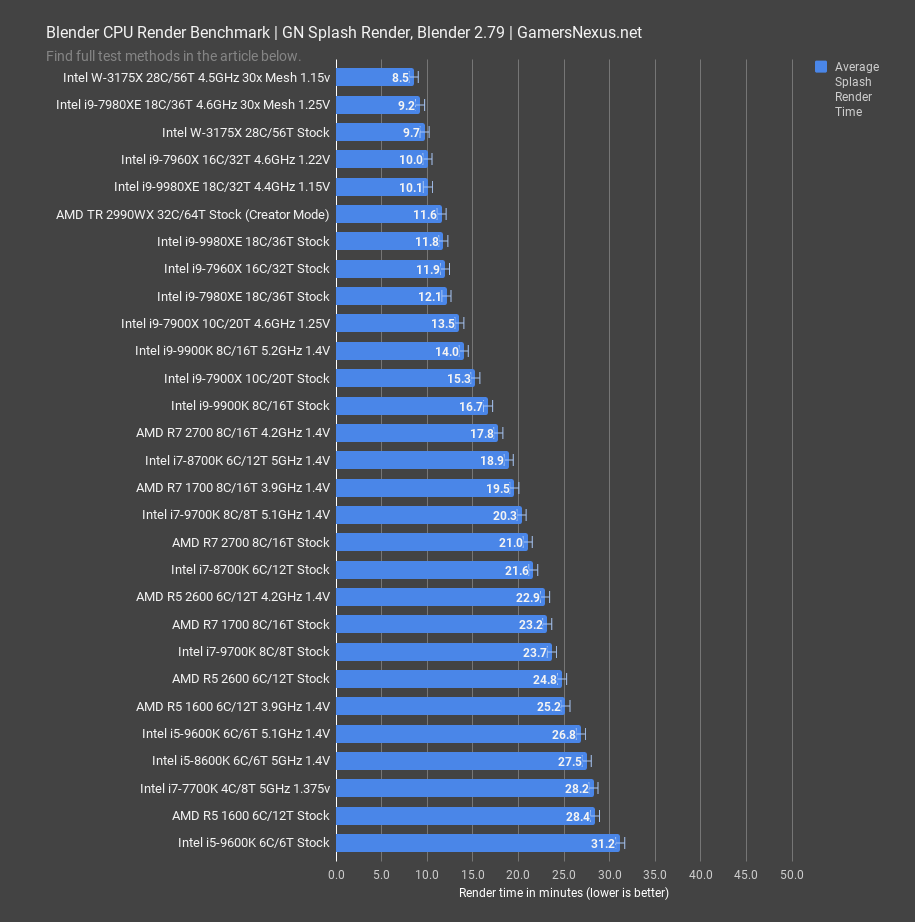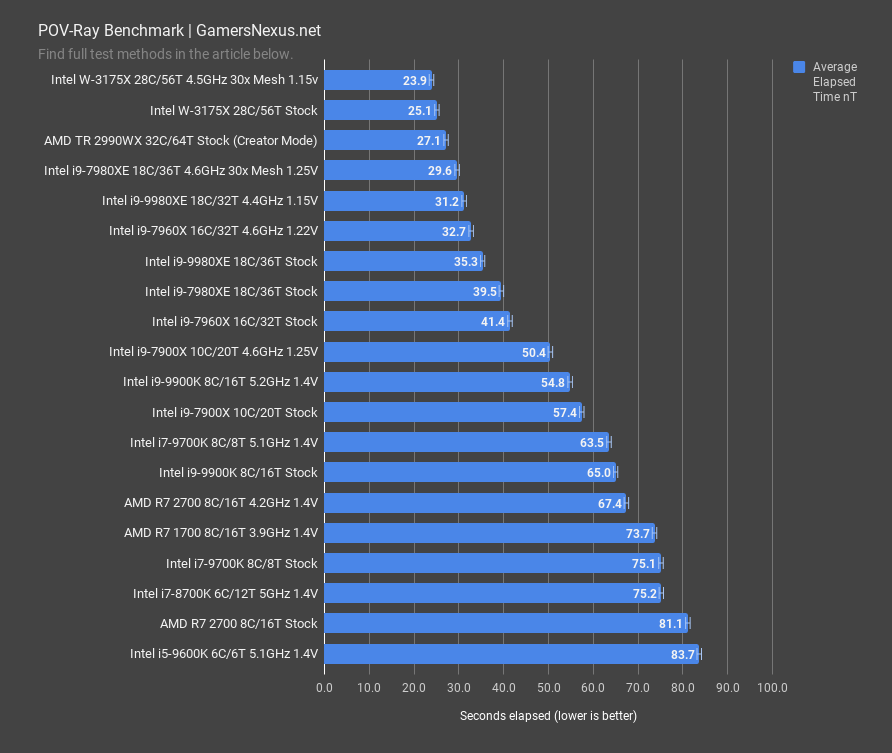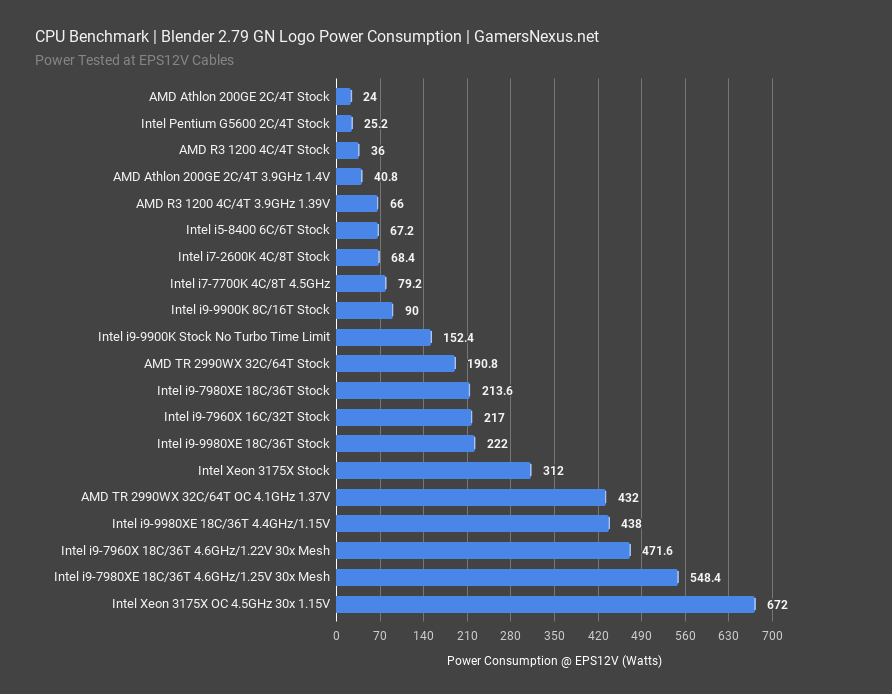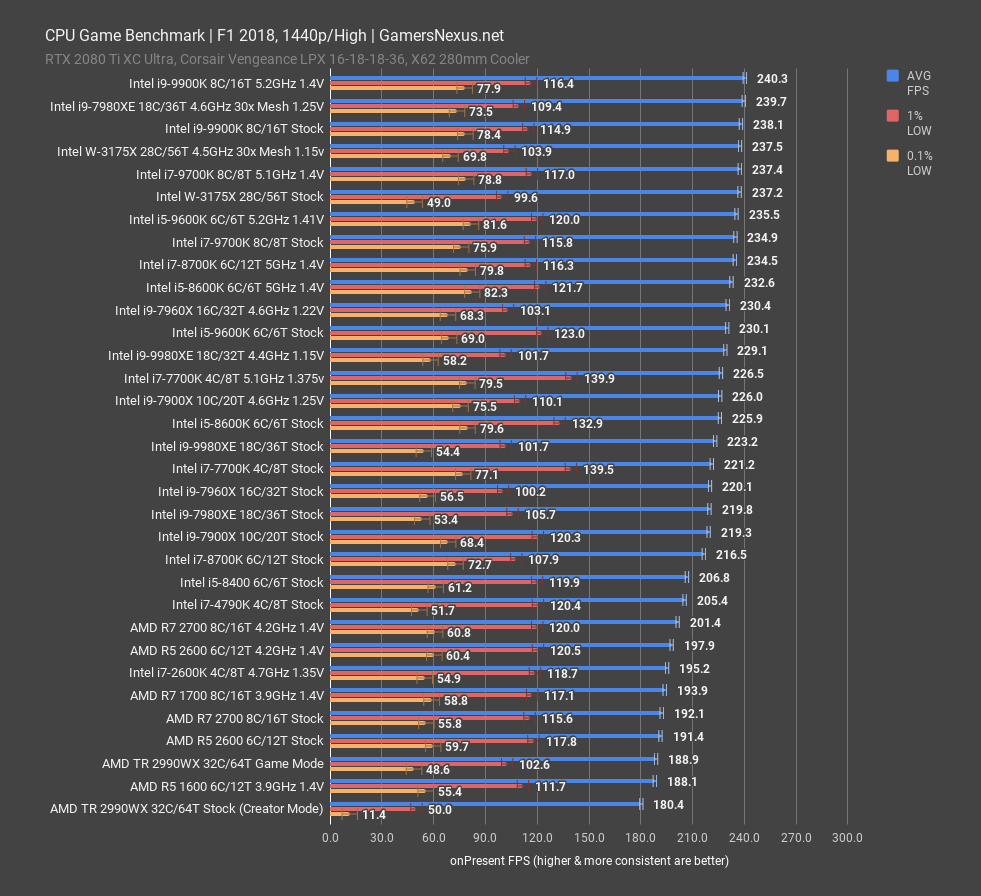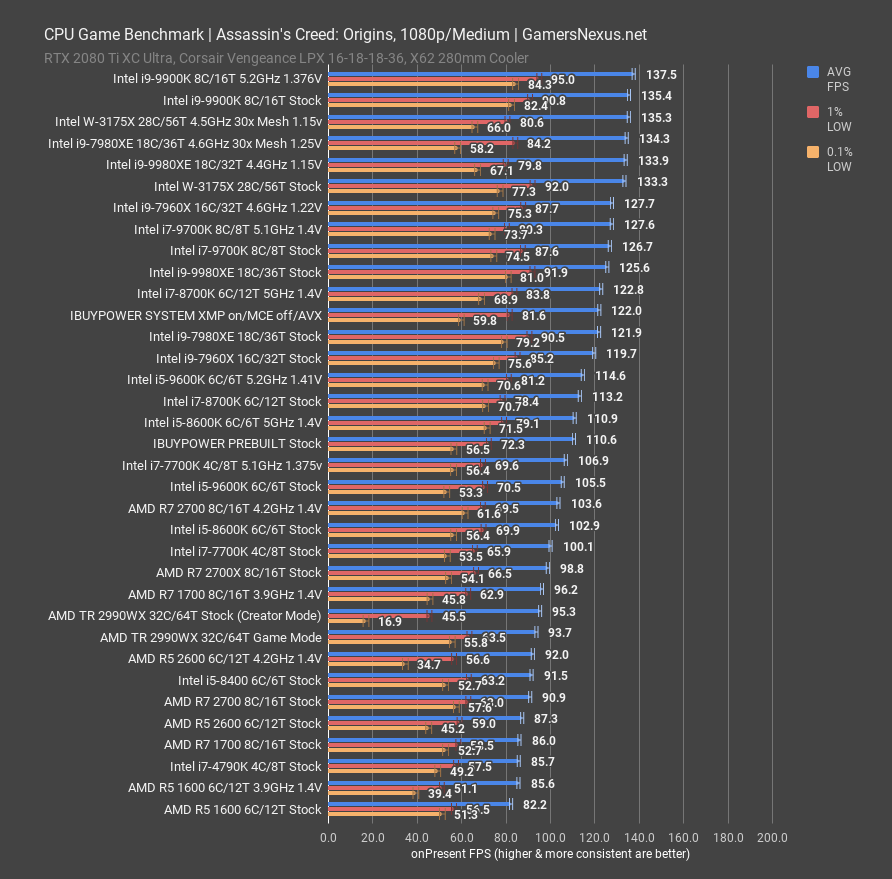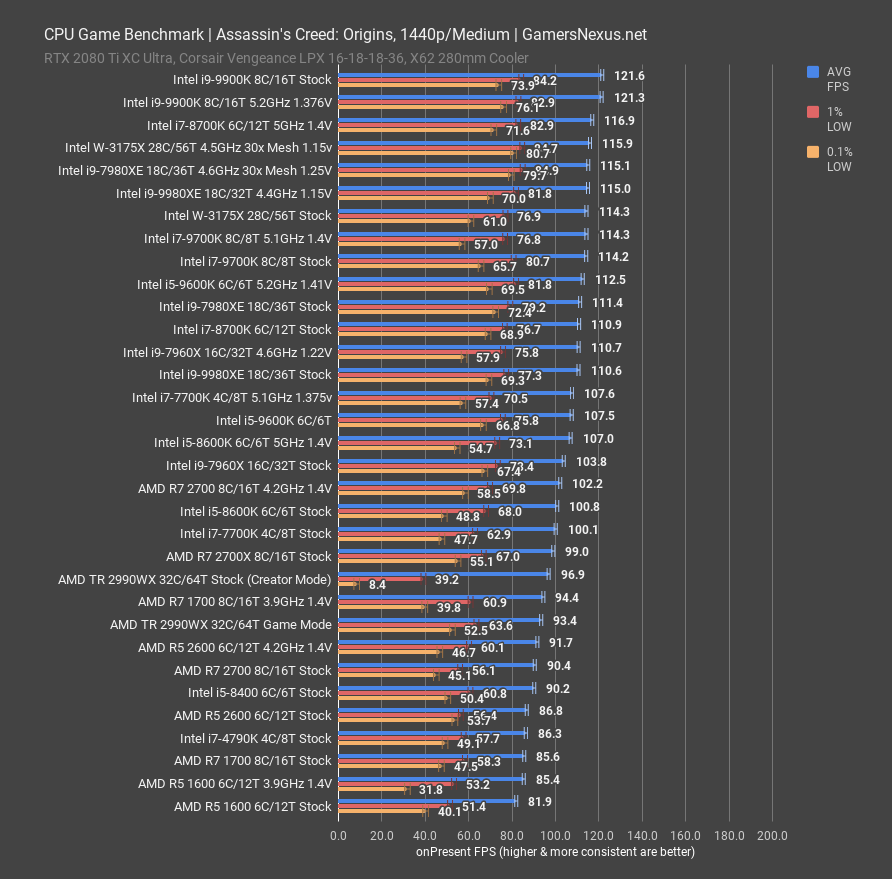The Intel Xeon W-3175X CPU is a 28-core, fully unlocked CPU capable of overclocking, a rarity among Xeon parts. The CPU’s final price ended up at $3000, with motherboards TBD. As of launch day – that’s today – the CPU and motherboards will be going out to system integrator partners first, with DIY channels to follow at a yet-to-be-determined date. This makes reviewing the 3175X difficult, seeing as we don’t yet know pricing of the rest of the parts in the ecosystem (like the X599 motherboards), and seeing as availability will be scarce for the DIY market. Still, the 3175X is first a production CPU and second an enthusiast CPU, so we set forth with overclocking, Adobe Premiere renders, Blender tests, Photoshop benchmarking, gaming, and power consumption tests.
Overclocking
Most of our overclocking detail will be revealed in our OC livestream tonight (6PM EST, 1/30/19), but we can also speak to the overclocking experience here.
The Intel Xeon W-3175X is a 28-core CPU, and that means it’s going to run unabashedly hot when overclocking. This is to be expected. We chose to test with the Asetek cooler shipped by Intel at first, as this is likely to be included in SI configurations. The cooler is weak when compared to the EK solution, primarily thanks to its usual Gen5/Gen6 pump block design coupled with an extended coldplate, but still gets the job done. We ended up stuck at around 4.5GHz / 1.15V (1.17V for Premiere) for our testing, with a quick mesh of 30x. Our overclock requirement for reviews is that the CPU must pass all tests, including our Blender AVX workloads, in order for the OC to be considered valid for review. We can push the clocks higher in non-AVX or game testing, where CPU load is lessened, but that doesn’t quite fit within our requirements. We’ll look at that more in the stream.
The biggest limiter to performance was thermals, as stock TjMax is 85 degrees Celsius and the stock interface is paste (between the die and IHS). Using the ASUS Dominus BIOS, we increased maximum core temperature to 90 degrees, allowing the 4.5GHz OC to run just below throttle point. A better cooler would be strongly advised, as we were operating at an intolerable 70dBA (at 20”) with the Asetek cooler, which is simply unsustainable beyond some benchmarking.
Beyond this, all overclocking is the same as Skylake-X, seeing as the part is Skylake-X architecture, ultimately.
Test Components
Tested CPUs primarily include the below list:
- Intel i9-9900K
- AMD R7 2700
- AMD R7 2700X
- Intel i7-8700K
- AMD R5 2600
- AMD R5 2600 OC (2600X stand-in)
- Intel i5-8600K
- Intel i9-7900X
- Intel i9-7960X
- AMD R7 1700
- Intel i7-4790K
Motherboards used for testing are as follows:
- ASUS Maximus XI Hero Z390
- Gigabyte Gaming 9 Z370
- Gigabyte Z97X Gaming G1 BK
- ASUS Crosshair VII Hero X470
- ASUS Crosshair VI Hero X370
- Gigabyte X299 Gaming 9
Constants used are as follows:
- All desktop platforms: 2x 8GB 3200MHz Corsair Vengeance LPX 16-18-18-36 DDR4
- (Exception: Z97X uses HyperX Savage 2133MHz DDR3)
- All quad-channel HEDT platforms: 4x 8GB 3200MHz Corsair Vengeance LPX 16-18-18-36 DDR4
- Corsair AX1600i PSU
- NZXT Kraken X62 at 100% speeds
- Note: 3175X system used 6 slots populated with 3200MHz Vengeance LPX
Adobe Premiere Benchmark
Our first test uses Adobe Premiere to encode a real GN clip. The video is an 11-minute truncated GPU review, using only a-roll and b-roll clips at 4K60 and rendered at 45Mbps. We’ll play some of that file back now so you can get an idea for what’s being rendered. The render is CUDA-accelerated, but the majority of the work still bottlenecks on the CPU. We firmly believe this is a real-world scenario, knowing most of the tech YouTubers you all watch, and find this a representative workload for content creators. H.264 is used, as YouTube still isn’t ready for primetime on H.265. Our years of experience with Premiere have taught us that our charts sections are heavily reliant upon the GPU, so those have been removed from CPU tests, and that working with high bitrate, high resolution files will stress the CPU heavily. This workload represents what we go through every day when rendering reviews.
Here’s our results chart. Adobe software in general, including Photoshop, really likes frequency. Premiere likes cores more than Photoshop, but is still heavily frequency dependent. The Intel i9-9900K stock CPU completed our render in 24 minutes, or 21 minutes when using QuickSync, which isn’t available on the HEDT CPUs. Note that IGP acceleration helps primarily with our charted reviews, but doesn’t do as much for heavy a-roll and b-roll videos like this one. The Intel i9-9980XE stock CPU completed the same render in 22% less time than the 9900K with IGP acceleration, with the $3000 Intel Xeon 3175X completing its render in 12 minutes, reducing the time required from the $2000 9980XE by 27%. How meaningful that improvement is will depend upon your use case: For professionals where every minute counts, like we’ll talk about in Blender for Threadripper momentarily, that 27% reduction for $1000 might be great value. For most of our normal audience, that’s pretty rough value when considering the already reasonable performance of the 9900K. It’s just going to depend on how much that time is worth to the individual or organization. For us, a 27% reduction would add up to several hours of render time per week, but for a hobbyist, it’s better value to buy something like the 9900K or 8700K.
As for Threadripper, it doesn’t handle our 4K60 clip as competitively as it handles Blender rendering, which we’ll look at next. This is an artifact of how applications are built: Premiere is built, at least with this standard YouTube-ready encoding configuration, to favor frequency heavily, and Threadripper does fall behind in that front. Load balancing isn’t as even across cores in Premiere as it is for Blender. In this scenario, Intel is the more consistent bet for our Premiere testing. Note that Premiere is a hugely complex program, so it is possible that there are some filters or effects where Ryzen does better than Intel, but we have not yet encountered them in our GN workloads. For this workload, Intel is firmly in the lead.
Blender Benchmark
Blender got a lot of mentions in the Premiere section. Blender is one of the world’s most heavily used 3D modeling and animation programs, and is another one that we use in-house for our own 3D work. Andrew, the editor for this video, made our GN intro logo in Blender – shown on screen now – which has proven to be one of the most intensive render scenes we’ve tested. The scene traces rays for lighting effects and has high sample counts for cinema-ready quality. Andrew also made our upcoming RAM timing explanation animations, but we’ll only show a short teaser clip of that for this review.
We’ve found that AMD’s Threadripper CPUs tend to do well with the GN logo animation, for which we’ll show data now. The performance between CPUs changes depending on the type of animation, so we have multiple tests we run to get a full picture of the lineup.
The $3000 Intel Xeon 3175X stock CPU completes the GN logo render in 9.3 minutes, functionally equivalent to the $1800 2990WX – and that’s not counting the high board cost for the X599 platforms. Where Intel looked very compelling in the Premiere bench, AMD looks compelling in the Blender tests. A 0.2-minute difference, or about 12 seconds, is within error margins. We didn’t get a chance to overclock our loaner 2990WX, unfortunately, but Intel’s 3175X demonstrates that there is limited scaling at this level of performance. Blender is hugely thread-dependent, and cares about threads more than anything else. Even hyperthreading offers great value in Blender, as illustrated by the difference between the 8700K and 9600K when both are at about 5GHz, something we can highlight. Overclocking the 3175X does get it a time reduction of 8.6%, but the power consumption and noise increases counter much of that gain.
Finally, for reference, the $2000 9980XE CPU completes the scene in 13.8 minutes when stock, with the 7980XE at 4.6GHz finishing the scene in 10 minutes. If you need to save $1000, the 2990WX or 7980XE might both be considerations.
Switching to our chart for the GN monkey head render, the scene you see on the screen now (in the video), we can look at performance for multiple types of rendering effects and techniques. This includes material type changes, transparencies, and changes to roughness and albedo to create a realistic stress test. AMD and Intel deviate more in this workload than our heavily ray-traced GN logo render, with AMD completing the render in 10.9 minutes on the 2990WX and Intel’s 3175X at 7.8 minutes, for a 28% render time reduction when both are stock. The 9980XE completes the same scene in 11.6 minutes, demonstrating that the 2990WX maintains a general lead with thread-count, but starts to exchange some of its lead with Intel at the high-end.
Finally, for the Splash render, the 3175X completes in about 9.7 minutes, with the 2990WX at 11.6 minutes and the 9980XE stock CPU at 11.8 minutes. That rough 16% time reduction against either $2000 option is hard to justify in a lot of instances, especially since overclocking the 9980XE gets it to nearly tie the 3175X – though you could then OC the 3175X for another one-minute reduction. It’s just a question of if the business considering this option would get benefit daily, in which instance the cost may be worth it, but it does really have to be a business to start making sense.
Photoshop Benchmark
Photoshop tends to be more frequency-dependent than anything, as evidenced by this chart. The 9900K is the best value here – by a longshot, too – and the 3175X only begins to compete once it’s been overclocked to 4.5GHz. Using the Puget Systems Photoshop benchmark, we simply cannot justify the 3175X for this use case. A much lower-end, higher-frequency Intel part makes far more sense than these HEDT platforms. There may be Photoshop use cases where it really makes sense, like maybe accompanying photo management tasks, but we could not find them in the comprehensive Puget test that we use.
POV-Ray Benchmark
POV-Ray is our last production test. This one positions the 3175X stock CPU at 25 seconds for multi-threaded elapsed time to complete the render, with the 2990WX stock CPU at 27 seconds to complete. The difference is outside of error margins, but generally insignificant. The 7980XE at 4.6GHz completes in 29.6 seconds, demonstrating that the extra threads in the 3175X are put to work. Overall, though, the $1000 difference is tough to accept for these leads. Overclocking pushes the 3175X further up the chart, though at the cost of power and significant noise on the Asetek cooler. The 3175X holds a bigger lead in single-threaded performance with POV-Ray, but then so does a 9900K.
Power
Power consumption is, expectedly, rather high with this CPU. With Blender and stock settings, the 3175X ends up following the Turbo duration limitations set by Intel after the load period. The power consumption down the EPS12V cables is 312W – remember, this isn’t total system draw, so we are looking at numbers much closer to actual power consumption. The 2990WX ran about 191W in this test, or roughly 16A. This is the same logo render that completed in equal times on the 2990WX and 3175X, so AMD is significantly advantaged in power consumption for this test, despite Intel being significantly ahead in Premiere testing. Overclocking the 3175X gets it up to a staggering 672W, which is the highest power consumption we’ve yet measured without using exotic cooling. The 7980XE at 1.25V was about 548W and the 2990WX at 1.37V ran 432W.
Games – F1 2018 Benchmark with Xeon 3175X
Games aren’t really the targeted use case of the 3175X, much like they aren’t the intended use of the 2990WX, but we always benchmark games. It is, after all, GamersNexus.
In F1 2018 at 1080p, the Intel 3175X ended up at 290FPS AVG, with lows mostly reasonably timed, sans the 0.1% values. We’ll look at frametimes to illustrate this behavior momentarily. The average framerate positioning ranks the CPU as functionally equivalent to a 9900K stock CPU – no human could meaningfully tell the difference between an average of 290FPS and 284FPS, though the 0.1% lows may be more meaningfully noticeable. F1 2018 likes cores more than most games, evidenced by the overclocked 3175 managing to land freshly at the top of the chart with its 308FPS AVG, within error and GPU limitations of the 7980XE at 4.6GHz. The 9900K at 5.2GHz further illustrates the thread favor in F1, as its performance tops-out at 291FPS AVG, in spite of its higher frequency.
Frametimes are important, here. Remember that we want to see a lower number for frametime, but also one which is consistent frame-to-frame. From one frame to the next, we don’t want to see a delta greater than 8-12ms, as this becomes noticeable to the user as a stutter. This is the data that gets smoothed-out in average charts, and is even smoothed-out by 1% metrics, illustrated in the previous chart. For frametimes, we see the 3175X spike to 20ms once, not too different from the 9900K, but then the 3175X spikes to 35ms, draws at 8ms for a bit, hits 34ms, then goes back down to 5ms, then hits 35ms, and so forth. This sporadic behavior is jarring to the user and, although not unplayable, the 9900K is a better experience despite its overall lower average FPS. Threadripper also has issues with a lot of games if left in Creator Mode with all cores enabled, so this seems to be a pattern with how games perceive the massive amount of cores. It may be best to disable some cores or use process lasso to set the used cores for an application.
Resolution is the great equalizer for gaming performance among CPUs, as the task instead becomes GPU bound. At 1440p, F1 2018 positions the 3175X at 237FPS AVG, which is about where the overclocked variant, the 9700K at 5.1GHz, and the 9900K all get stuck. This is GPU-bound.
Games – Assassin’s Creed: Origins Benchmark with Xeon 3175X
Assassin’s Creed: Origins is up next. At 1080p, the 3175X ends up at 133FPS AVG stock, which is between the 9980XE at 4.4GHz and 9700K at 5.1GHz. This is another instance where it is clearly more sensible to buy a more gaming-centric CPU for gaming. Just like Threadripper or other Xeon parts before, you should not buy the 3175X for a gaming PC. It’s fine for use in a workstation PC that also plays games sometimes, but it is not suitable for use as a gaming-only CPU. Being the most expensive doesn’t make the CPU the best at gaming, though it may help in being good at its more specialized workstation tasks with some gaming on the side. The 3175X is capable in this test, though clearly not a distinctive leader when compared to Intel’s gaming-centric CPUs, like the 9900K or 9700K.
1440p shows mostly the same thing: Despite being up against a GPU bottleneck, the 3175X falls slightly behind the 9900K, likely resultant of lower single-threaded performance when considering the 9900K’s higher frequencies.
Games – Civilization VI with Xeon 3175X
Civilization VI will be our last one for today. We have more gaming benchmarks, but as this isn’t really gaming-targeted, we’ll cap it here for time; besides, the conclusion remains the same across all the titles. Civilization VI looks instead at AI turn time processing instead of FPS, which is a more useful metric for grand campaign and turn-based strategy games. For this one, the 3175X technically chart tops – within error margins, anyway – at 11.2 seconds when overclocked to 4.5GHz. Calculated across hundreds of turns and 5 AI, this would certainly add up when compared to, for instance, an i3 or R3 CPU. Realistically, though, the difference between an 11.2-second time and an 11.4-second time out of the 9700K isn’t noticeable, and the 3175X stock performance is more realistically comparable to a 9900K stock. Again, the 3175X does well, but it’s not like performance scales linearly with the money spent.
Conclusion
As stated earlier (and prominently in the video), this part is sort of hard to review from our normal vantage point. It’s not really available for consumers – at least, not yet – and is starting life as a system integrator (SI) part. The Dominus motherboard doesn’t even have an official price and won’t be available via retail channels anytime in the immediate future, and the Gigabyte board appears to be of a similar fate. This is not a DIY, enthusiast-ready part at launch, unfortunately, and so we struggle to evaluate its value without knowing the average motherboard cost. We’ve heard upwards of $1700 for the ASUS board.
Ignoring these unknowns and focusing only on performance, we know the following:
- Intel’s W-3175X exhibits stellar Adobe Premiere rendering performance with high-bitrate, high-resolution a-roll and b-roll scenes (those which depend on the CPU for rendering). The 3175X completes our benchmark render in about 12 minutes stock, 9-10 overclocked, versus the 9900K’s 21-minute IGP-accelerated render time. That’s impressive, and there are many businesses – including ours – where those performance increases would outweigh the $1000 differential versus the 9980XE. For people who render every single day, multiple videos per day, there are bottom line cost savings that can be enacted with the faster part. For hobbyists or more budget-conscious outlets that render less frequently, the 9900K makes far more financial sense and isn’t that much slower. The 3175X is impressive in Premiere, though.
- For Photoshop, we have observed no benefit to purchasing the 3175X or 2990WX CPUs. Photoshop is still heavily frequency dependent, and therefore would be better suited with a much cheaper 9900K.
- For Blender, the 3175X is ahead of the 2990WX on average, but the gaps are oft insignificant. In our most intensive render, the difference between the 3175X and 2990WX is about 12 seconds, and so the two complete in functionally the same time. The 2990WX, meanwhile, is $1000 cheaper, has motherboards that are probably similarly reduced in price, runs at much lower power consumption, and can use cheaper cooling. You could buy two 2990WX CPUs and motherboards for the cost of one 3175X CPU and motherboard. We have to give the better value to AMD in Blender; despite Intel’s definitive lead in Premiere, Blender is less frequency-dependent and allows AMD a stronger overall position.
- POV-Ray is a similar story: AMD and Intel end up nearly tied in multi-threaded workloads between the 3175X and 2990WX.
- For gaming, the 3175X pulls far ahead of the 2990WX, but is (obviously) still worse on average than a 9900K. This is not a CPU you buy for a gaming-only machine; it’s fine to game on the side, in addition to workstation tasks, but not as a primary task. Some games have more variable frametime consistency than we like, so some process lassoing may do well to aid with that.
From an overclocking enthusiast standpoint, the CPU really needs help to excel to its fullest abilities. It’s not soldered, so delidding and switching to liquid metal would alleviate some thermal load (without going to a chiller). The Asetek option is also unacceptable for a reasonable use case: Our overclock (for this review) ran at 4.5GHz / 1.15V (exception: Premiere at 1.17V) on the Asetek cooler, and that required bumping the maximum core temperature from a stock TjMax of 85C to 90C. We were within single-digit degrees of throttling constantly, and that was while running with a 70dBA noise level (measured at 20”). The EK solution is significantly better, but we are saving that overclock effort for our livestream tonight (1/30/19 at 6PM EST). To reach 5GHz will require high-end cooling and a good chip, or more realistically, chilled water.
We find the 3175X to be an impressive CPU overall. Its performance is objectively good, it’s just a matter of where the extra spend makes sense. For Blender, we do think that the 2990WX could work out to be better overall value with near identical performance, especially considering that a second 2990WX could be purchased at the cost difference. For Premiere, the 3175X is hands-down impressive, and if we find budget, we may buy one for our own rendering machines. For gaming and Photoshop, the 9900K still makes more sense, with the 2700 obviously posting good performance in a different price class of CPU. The 3175X review remains difficult to conclude without knowing board prices and if it’ll ever come to consumers outside of the SI market, but our understanding is that some major retailers do intend to sell the chip standalone.
Editorial, Testing: Steve Burke
Testing: Patrick Lathan
Video: Andrew Coleman

